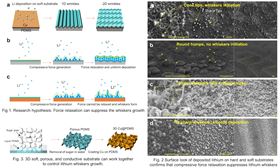 These images show how using silicone as the substrate for a lithium metal anode can mitigate the formation of dendrites, dramatically extending battery life and diminishing safety risks. Images: Arizona State University.
These images show how using silicone as the substrate for a lithium metal anode can mitigate the formation of dendrites, dramatically extending battery life and diminishing safety risks. Images: Arizona State University.Lithium-metal batteries are among the most promising candidates for high-density energy storage technology in an expanding range of digital ‘smart’ devices and electrical vehicles. But uncontrolled lithium dendrite growth, which results in poor recharging capability and safety hazards, currently tempers their potential.
Dendrites are needle-like growths that appear on the surface of lithium metal, which is used as the anode, or negative electrode, of the battery. They induce unwanted side reactions that reduce energy density and, at worst, cause shorting of the electrodes that can lead to fires or explosions.
Now, scientists at Arizona State University have found that using a three-dimensional layer of polydimethylsiloxane (PDMS), or silicone, as the substrate for a lithium metal anode can mitigate dendrite formation and thus dramatically extend battery life and diminish safety risks. They report their findings in a paper in Nature Energy.
According to Hanqing Jiang, a professor in Arizona State University's School for Engineering of Matter, Transport and Energy and lead researcher of the study, the findings also have relevance for both lithium-ion and lithium-air batteries, as well as implications for other metal-anode-based batteries.
"Almost all metals used as battery anodes tend to develop dendrites," explained Jiang. "For example, these findings have implications for zinc, sodium and aluminum batteries as well."
Jiang said that, rather than approaching the problem from a materials or electrochemical perspective, he and his colleagues looked for solutions as mechanical engineers. "We already know that tiny tin needles or whiskers can protrude out of tin surfaces under stress, so by analogy we looked at the possibility of stress as a factor in lithium dendrite growth."
The first round of research involved adding a layer of PDMS to the bottom of a battery anode. "There were remarkable reductions in dendrite growth," said Jiang. The researchers discovered this was because deformations of the PDMS substrate in the form of ‘wrinkles’ helped to relieve stress accumulating inside the lithium metal.
"This is the first time convincing evidence shows that residual stress plays a key role in the initiation of lithium dendrites," said Jiang.
In addition to obtaining a fundamental understanding of the lithium dendrite growth mechanism, Jiang's group also came up with a smart way to utilize the stress-relieving phenomenon to extend the life of lithium-metal batteries while maintaining their high energy density. The solution is to give the PDMS substrate a three-dimensional form with a lot of surface area.
"Envision sugar cubes that contain a lot of small internal pores," explained Jiang. "Inside these cubes, the PDMS forms a continuous network as the substrate, covered by a thin copper layer to conduct electrons. Finally, lithium fills the pores. The PDMS, which serves as a porous, sponge-like layer, relieves the stress and effectively inhibits dendrite growth."
"By synergistically combing with other lithium dendrite suppression methods such as new electrolyte additives, the finding has broad implications for making lithium-metal batteries a safe, high-density, long-term energy storage solution," said Ming Tang, a research team member at Rice University. "Potential applications range from personal electronic devices to powering electric cars for exceptionally longer periods to being the back-up electric supply for solar power grids."
This story is adapted from material from Arizona State University, with editorial changes made by Materials Today. The views expressed in this article do not necessarily represent those of Elsevier. Link to original source.